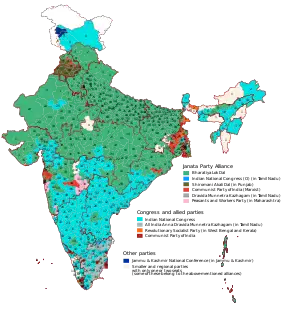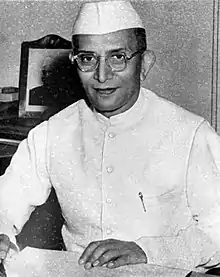1977 Indian general election
The 1977 Indian general election was held to constitute the 6th Lok Sabha. Polling was held between 16 to 20 March 1977. It was held during the Emergency period, which expired on 21 March 1977, right before the final results were announced.[2]
| ||||||||||||||||||||||||||||
All 542 seats in the Lok Sabha 272 seats were needed for a majority | ||||||||||||||||||||||||||||
|---|---|---|---|---|---|---|---|---|---|---|---|---|---|---|---|---|---|---|---|---|---|---|---|---|---|---|---|---|
| Turnout | 60.49% | |||||||||||||||||||||||||||
| ||||||||||||||||||||||||||||
 | ||||||||||||||||||||||||||||
| ||||||||||||||||||||||||||||
The election resulted in a heavy defeat for the Indian National Congress (INC) government, with the incumbent Prime Minister and INC party leader Indira Gandhi losing her Lok Sabha seat from Rae Bareli. The call for restoration of democracy by revoking the Emergency is considered to be a major reason for the sweeping victory for the opposition Janata alliance,[3] whose leader Morarji Desai was sworn in as the fourth Prime Minister of India on 24 March 1977.
Background
India held general elections to the 6th Lok Sabha. This sixth general elections, which were conducted for 542 seats from 542 constituencies, represented 27 Indian states and union territories.[4] These 542 constituencies remained same until 2004 Indian general elections for the 14th Lok Sabha.
The Emergency declared by the Indira Gandhi led Congress government was the core issue in the 1977 elections. Civil liberties were suspended during the national emergency from 25 June 1975 to 21 March 1977 and Prime Minister Indira Gandhi assumed vast powers.
Gandhi had become extremely unpopular for her decision and paid for it during the elections. On 18 January, Gandhi called for fresh elections and released all political prisoners.[5] On 20 January, four opposition parties, the Congress (Organisation), the Jan Sangh, the Bharatiya Lok Dal and the Socialist Party, decided to fight the elections under a single banner called the Janata alliance.[1] The alliance used the symbol allocated to Bhartiya Lok Dal as their symbol on the ballot papers.
The Janata alliance reminded voters of the excesses and human rights violations during the Emergency, like compulsory sterilisation and imprisonment of political leaders. The Janata campaign said the elections would decide whether India would have "democracy or dictatorship."[6] The Congress looked jittery. Agriculture and Irrigation Minister Babu Jagjivan Ram quit the party in the first week of February; other notable Congress stalwarts who crossed the floor with Jagjivan Ram before the election were Hemvati Nandan Bahuguna and Nandini Satpathy.
Results
Results by alliance
Source: Keesings[7]
| Alliances | Party | Seats won | Change | Popular votes % |
|---|---|---|---|---|
| Janata Alliance Seats: 345 Seat Change: +233 Popular vote %: 51.89 |
Janata Party / Congress for Democracy | 298 | +245 | 43.17 |
| Communist Party of India (Marxist) | 22 | -3 | 4.30 | |
| Shiromani Akali Dal | 9 | +8 | 1.26 | |
| Peasants and Workers Party of India | 5 | — | 0.55 | |
| Revolutionary Socialist Party | 3 | +2 | n/a | |
| All India Forward Bloc | 3 | +2 | 0.34 | |
| Republican Party of India (Khobragade) | 2 | +1 | 0.51 | |
| Dravida Munnetra Kazhagam | 1 | -22 | 1.76 | |
| Independents | 2 | — | — | |
| Congress Alliance Seats: 189 Seat Change: -217 Popular Vote %: 40.98 |
Indian National Congress (Indira) | 153 | −197 | 34.52 |
| All India Anna Dravida Munnetra Kazhagam | 19 | — | 2.9 | |
| Communist Party of India | 7 | -16 | 2.82 | |
| Jammu & Kashmir National Conference | 2 | — | 0.26 | |
| Indian Union Muslim League | 2 | -2 | 0.3 | |
| Kerala Congress | 2 | -1 | 0.18 | |
| Revolutionary Socialist Party (breakaway) | 1 | -1 | — | |
| Independents | 2 | — | — | |
| Others Seats: 19 |
Others | 19 | — | — |
Results by Party
 | |||||
| Lok Sabha elections 1977 Electoral participation: 60.49% |
% | Won (total 545) | |||
|---|---|---|---|---|---|
| Janata Party/ Bharatiya Lok Dal [8] | JP | 41.32 | 295 | ||
| Communist Party of India | CPI | 2.82 | 7 | ||
| Communist Party of India (Marxist) | CPI(M) | 4.29 | 22 | ||
| Indian National Congress | INC(I) | 34.52 | 154 | ||
| Congress For Democracy (Jagjivan Ram) | CFD (with Janata Party) | 5.28 | 13 | ||
| All India Anna Dravida Munnetra Kazhagam | AIADMK | 2.9 | 18 | ||
| All India Forward Bloc | AIFB | 0.34 | 2 | ||
| Dravida Munnetra Kazhagam | DMK | 1.76 | 2 | ||
| Indian Union Muslim League | IUML | 0.3 | 2 | ||
| Jammu & Kashmir National Conference | NC | 0.26 | 2 | ||
| Kerala Congress | KC | 0.18 | 1 | ||
| Maharashtrawadi Gomantak Party | MGP | 0.06 | 1 | ||
| Manipur Peoples Party | MPP | 0.06 | 0 | ||
| Muslim League (Opposition) | ML(O) | 0.17 | 0 | ||
| Peasants and Workers Party of India | PWPI | 0.55 | 5 | ||
| Revolutionary Socialist Party | RSP | 0.45 | 4 | ||
| Shiromani Akali Dal | SAD | 1.26 | 9 | ||
| United Democratic Front | UDF | 0.07 | 1 | ||
| Vishal Haryana | VH | 0.1 | 1 | ||
| Jharkhand Party | JP | 0.07 | 1 | ||
| Republican Party of India (Khobragade) | RPI(K) | 0.51 | 2 | ||
| Independents | – | 5.5 | 9 | ||
| Nominated Anglo-Indians | – | – | 2 | ||
Voter behaviour
The elections in India's largest state Uttar Pradesh, historically a Congress stronghold, turned against Gandhi. Dhanagare says the structural reasons included the emergence of a strong and united opposition, disunity and weariness within the Congress, an effective opposition and the failure of Gandhi in controlling the mass media, which was under censorship during the Emergency. The structural factors allowed voters to express their grievances, notably their resentment of the emergency and its authoritarian and repressive policies. One grievance often mentioned was the 'Nasbandi' (vasectomy) campaign in rural areas. The middle class also emphasised on the curbing of freedom of speech throughout the country.[9]
Meanwhile, Congress hit an all-time low in West Bengal, according to the Gangulys, because of poor discipline and factionalism among Congress activists as well as numerous defections that weakened the party. Opponents emphasised the issues of corruption within the Congress and appealed to a deep desire by the voters for fresh leadership.[10] The Congress, however, did well in southern states of Tamil Nadu, Karnataka, Kerala and Andhra Pradesh. The results were mixed in the western states of Maharashtra and Gujarat, although the Janata alliance won all the seats in Mumbai.
References
- http://www.ipu.org/parline-e/reports/arc/INDIA_1977_E.PDF
- "India 1977" (PDF).
- M.R. Masani, "India's Second Revolution," Asian Affairs (1977) 5#1 pp 19–38.
- "General Election of India 1977, 6th Lok Sabha" (PDF). Election Commission of India. p. 6. Archived from the original (PDF) on 18 July 2014. Retrieved 13 January 2010.
- https://www.freepressjournal.in/webspecial/from-fpj-archives-emergency-impact-indira-gandhi-loses-elections-india-gets-first-non-gandhi-pm
- "INKredible India: The story of 1977 Lok Sabha election - All you need to know".
- "Janata Party Victory in Lok Sabha Elections - Emergency lifted - Cabinet formed by Mr Desai - Dissolution of Nine State Assemblies - Merger of Janata Party and Congress for Democracy - Developments in States - Relations with Soviet Union and China | Keesing's World News Archives". Keesings.com. Retrieved 18 August 2014.
- "1977 Lok Sabha elections Statistical Report".
- D.N. Dhanagare, "Sixth Lok Sabha Election in Uttar Pradesh – 1977: The End of the Congress Hegemony," Political Science Review (1979) 18#1 pp 28–51
- Mira Ganguly and Bangendu Ganguly, "Lok Sabha Election, 1977: The West Bengal Scene," Political Science Review (1979) 18#3 pp 28–53
Further reading
- Guha, Ramachandra. India After Gandhi: The History of the World's Largest Democracy (2008) pp 491–518
- Klieman, Aaron S. "Indira's India: Democracy and Crisis Government," Political Science Quarterly (1981) 96#2 pp. 241–259 in JSTOR
- Roy, Ramashray; Sheth, D. L. "The 1977 Lok Sabha Election Outcome: The Salience of Changing Voter Alignments Since 1969," Political Science Review (1978), Vol. 17 Issue 3/4, pp 51–63

%252C_Bestanddeelnr_929-0811_(cropped).jpg.webp)